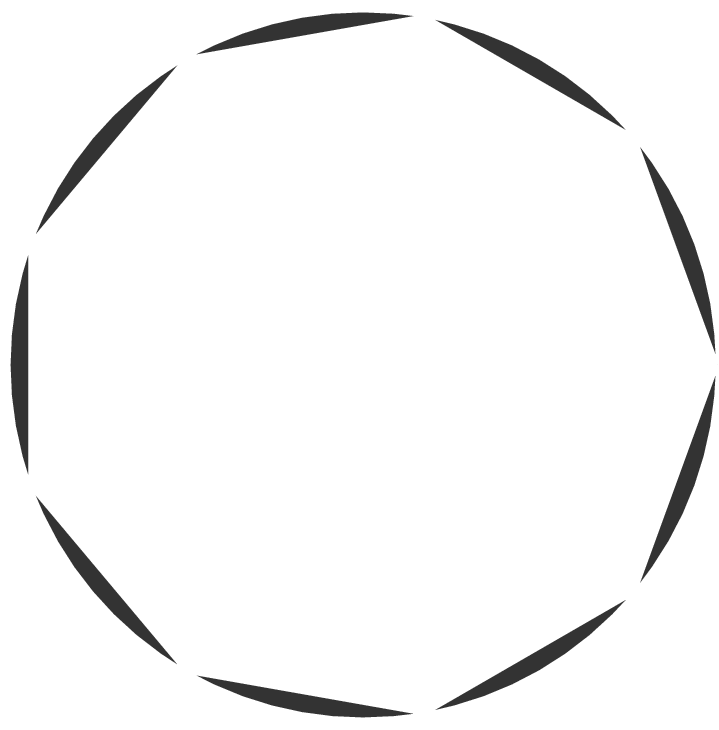Make lens aperture in Tikz
A little late, but the following defines a pic that is more or less configurable (and I promptly used it to create an animation). The calculations are most likely inefficient and the overall code doesn't look as good as those posted by the usual TikZ experts.
\documentclass[tikz]{standalone}
\tikzset
{
,aperture segments/.initial = 6
,aperture radius/.initial = 3
,aperture closed/.initial = .5
,aperture/.pic={
\begin{scope}
\pgfkeysgetvalue{/tikz/aperture segments}\segments
\pgfkeysgetvalue{/tikz/aperture radius}\rad
\pgfkeysgetvalue{/tikz/aperture closed}\closed
\pgfmathsetmacro\ang{360/\segments}
\pgfmathsetmacro\endang{360-\ang}
\pgfmathsetmacro\alphtild{(180-\ang)/2}
\pgfmathsetmacro\rp{(1-\closed)*\rad}
\pgfmathsetmacro\cc{\rad*sqrt(2*(1-cos(\ang)))}
\pgfmathsetmacro\bp{sqrt(\rad*\rad+\rp*\rp-2*\rad*\rp*cos(\ang))}
\pgfmathsetmacro\alphprim{asin(\rp/\bp*sin(\ang))}
\pgfmathsetmacro\alph{\alphtild-\alphprim}
\pgfmathsetmacro\bet{180-\ang-\alph}
\pgfmathsetmacro\bb{\cc*sin(\bet)/sin(\ang)}
\foreach \r in {0,\ang,...,\endang}
{
\filldraw[fill = black!80, draw = white, thick, rotate = \r]
(0:\rad) ++(180-\alphprim:\bb) -- (0:\rad)
arc[start angle=0, end angle=\ang, radius=\rad]
-- cycle;
}%
\end{scope}%
}
}
\begin{document}
\foreach\x in {0,0.025,...,1}
{
\begin{tikzpicture}
\pic [aperture segments=9, aperture closed=\x] {aperture};
\end{tikzpicture}
}
\foreach\x in {1,0.975,...,0}
{
\begin{tikzpicture}
\pic [aperture segments=9, aperture closed=\x] {aperture};
\end{tikzpicture}
}
\end{document}

A small document which describes what is calculated above and why:
\documentclass[]{article}
\title{Aperture drawing}
\author{Skillmon}
\date{}
\usepackage{tikz}
\usepackage[]{amsmath}
\usepackage{array}
\usepackage{collcell}
\usepackage{booktabs}
\usepackage{siunitx}
\newcolumntype\mathcol[1]{>{\startmath}#1<{\endmath}}
\let\startmath\(
\let\endmath\)
\newcolumntype\macrocol[1]{>{\collectcell\makemacroname}#1<{\endcollectcell}}
\newcommand\makemacroname[1]
{%
\texttt{\expandafter\string\csname #1\endcsname}%
}
\begin{document}
\maketitle
The geometry we use is shown in figure~\ref{fig:geom}.
In the equations below variables correspond to the names in the used
Ti\textit{k}Z code to draw the aperture. The correspondences are shown in
table~\ref{tab:corres}. In the following I don't care about the sign of the
angles denoted with $\angle P_1P_2P_3$ and always only care for their absolute
value, so $\angle P_1P_2P_3$ might actually be $\angle P_3P_2P_1$.
\begin{figure}
\centering
\begin{tikzpicture}
\def\segments{9}
\def\rad{3}
\def\closed{0.3}
\pgfmathsetmacro\ang{360/\segments}
\pgfmathsetmacro\endang{360-\ang}
\pgfmathsetmacro\alphtild{(180-\ang)/2}
\pgfmathsetmacro\rp{(1-\closed)*\rad}
\pgfmathsetmacro\cc{\rad*sqrt(2*(1-cos(\ang)))}
\pgfmathsetmacro\bp{sqrt(\rad*\rad+\rp*\rp-2*\rad*\rp*cos(\ang))}
\pgfmathsetmacro\alphprim{asin(\rp/\bp*sin(\ang))}
\pgfmathsetmacro\alph{\alphtild-\alphprim}
\pgfmathsetmacro\bet{180-\ang-\alph}
\pgfmathsetmacro\bb{\cc*sin(\bet)/sin(\ang)}
\draw
(0,0) coordinate(O) circle [radius=1.5pt] node [below]{$O$}
(0:\rad) coordinate(A) circle [radius=1.5pt] node [below right]{$A$}
++(180-\alphprim:\bb)
coordinate(C) circle [radius=1.5pt] node [above left]{$C$}
(\ang:\rad) coordinate(B) circle [radius=1.5pt] node [above right]{$B$}
(\ang:\rp) coordinate(D) circle [radius=1.5pt] node [below]{$D$}
;
\draw[blue]
(A) arc[start angle=0, end angle=40, radius=3cm] -- (C) -- cycle;
\draw[gray, dashed]
(O) -- (A)
(A) -- (B)
(O) -- (B)
;
\end{tikzpicture}
\caption
{%
The geometry in which we want to calculate the position of point $C$%
\label{fig:geom}%
}
\end{figure}
\begin{table}
\centering
\begin{tabular}{\mathcol{c} \macrocol{l} \mathcol{l}}
\toprule
\multicolumn{1}{l}{Variable} & \multicolumn{1}{l}{Macro name}
& \multicolumn{1}{l}{Meaning} \\
\midrule
\bar{p} & closed & \overline{DB}/\overline{OB} \\
n & segments \\
r & rad & \overline{OA}=\overline{OB} \\
\gamma & ang & \angle AOB \\
\tilde{\alpha} & alphtild & \angle OAB \\
r_p & rp & \overline{OD} \\
c & cc & \overline{BA} \\
b_p & bp & \overline{AD} \\
\alpha' & alphprim & \angle OAC \\
\alpha & alph & \angle CAB \\
\beta & bet & \angle ABC \\
b & bb & \overline{AC} \\
\bottomrule
\end{tabular}
\caption
{%
Variable-Macro-Correspondence and their geometrical meaning in
figure~\ref{fig:geom}.%
\label{tab:corres}%
}
\end{table}
The variables we know the values of are $n$, $r$, and $\bar{p}$. $\bar{p}$ is in
the range $[0,1]$ and describes how closed the aperture is. $n$ is the number of
aperture segments and $r$ is the outer radius of the aperture. From $n$ we get
the angle $\gamma = \angle AOB$ straight forward:
\begin{equation}
\gamma = \frac{\ang{360}}{n}
\end{equation}
Also relatively easy to calculate are the value of $p$ and $r_p$:
\begin{align}
p &= 1 - \bar{p} \\
r_p &= rp
\end{align}
The next thing we want to know is the angle $\angle ACB$. We know how many edges
the polygon of the aperture will have ($n$), so we know the sum
of internal angles and $\angle ACB$ is the adjacent angle of one of the internal
angles:
\begin{equation}
\angle ACB = \ang{180} - \ang{180} \frac{(n - 2)}{n}
= \ang{180} \cdot (1 - 1 + \frac{2}{n}) = \frac{\ang{360}}{n} = \gamma
\end{equation}
The distances $c$ and $b_p$ can be calculated using the law of cosines:
\begin{align}
c &= \sqrt{2r^2 - 2r^2\cos \gamma} = r \sqrt{2(1-\cos\gamma)} \\
b_p &= \sqrt{r^2 + r_p^2 - 2rr_p\cos\gamma} \label{eq:bp}
\end{align}
We could further simplify eq.~\ref{eq:bp}, but this should suffice.
$\tilde{\alpha}$ can be calculated with the sum of internal angles in the
triangle $OAB$ since it is isosceles. With the sine theorem we can calculate
$\alpha'$ and therefore $\alpha$ and $\beta$:
\begin{align}
\tilde{\alpha} &= \frac{\ang{180}-\gamma}{2} \\
\alpha' &= \arcsin ( \frac{r_p}{b_p}\sin\gamma ) \\
\alpha &= \tilde{\alpha} - \alpha' \\
\beta &= \ang{180} - \gamma - \alpha
\end{align}
Using the sine theorem again we calculate the value of $b$ and with the position
of $A$ and the angle $\alpha'$ we get the position of $C$:
\begin{equation}
b = c \frac{\sin\beta}{\sin\gamma}
\end{equation}
In Ti\textit{k}Z the point $C$ is now positioned at
\verb|(0:\rad) ++(180-\alphprim:\bb)|. Now we can draw our aperture segments.
\end{document}
You could draw triangles instead of rectangles:
\documentclass{article}
\usepackage{tikz}
\begin{document}
\begin{tikzpicture}
\clip (0,0) circle (1);
\foreach \r in {0,40,...,320}
\fill[black!80,rotate=\r] (-0.5,1) -- (-0.5,-0.13) --++ (130:1) -- cycle;
\end{tikzpicture}
\end{document}
